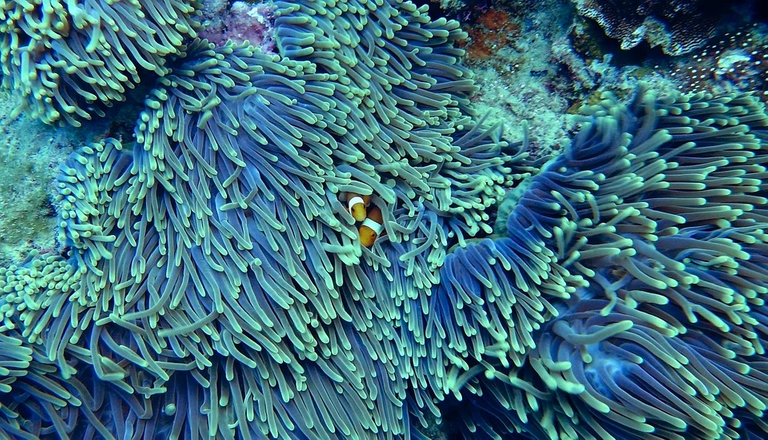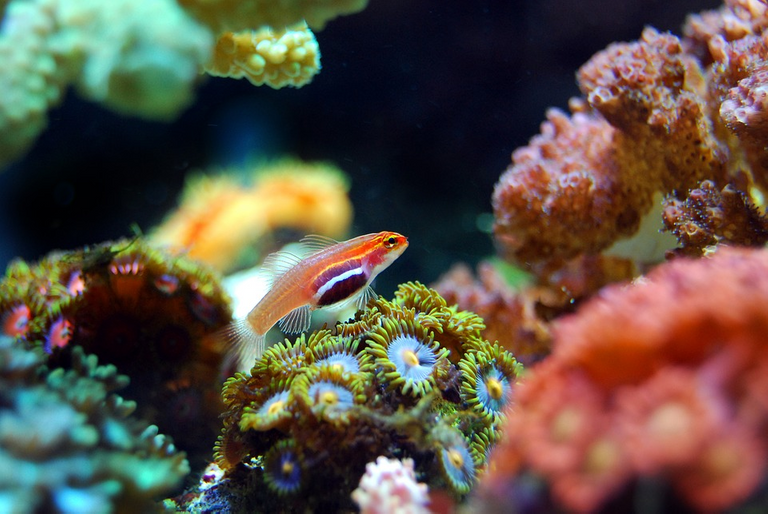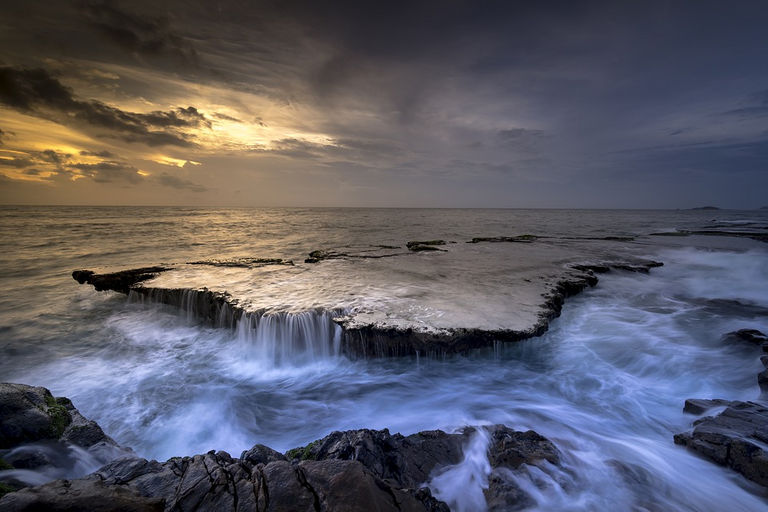La búsqueda del pulpo turquesa
Luego de cuatro meses de búsqueda, André por fin había logrado capturar una imagen, aunque borrosa, bastante prometedora de la existencia de aquella especie que tanto había buscado. El pulpo gigante turquesa estaba más cerca de las revistas científicas de lo que pudiera imaginarse. Gran parte de su carrera, se había centrado en el estudio de los pigmentos naturales que desarrollaban las plantas y algunos animales, asociándoles a ellos, ciertas propiedades químicas en función de su color, saturación, brillo y opacidad. Había también extraído, purificado y coleccionado un gran número de estos; al entrar en su laboratorio se podía fácilmente distinguir todos los colores del arcoíris.
A modo de fachada y para evitar preguntas impertinentes de sus vecinos, André solamente decía ser trabajador del sector que se encarga del desarrollo de nuevos pigmentos para pinturas industriales y de interés artístico. Antes los ojos de la sociedad, era un chico bastante tranquilo, y hábil en su búsqueda de nuevos colores, no era muy sociable, pero se le consideraba amable en cada gesto que tuviese con sus vecinos. Todos los días salía en busca de nuevas especies tanto terrestres como marinas, pero dada la cercanía de la ciudad con la playa, prefirió enfocarse en las especies que allí vivían.
Solamente su mejor amigo sabía de las pruebas biológicas que estaba realizando en laboratorio. Antes de irse del país le advirtió en reiteradas ocasiones los peligros legales que estaba corriendo al hacer ese tipo de actividades sin los permisos que el estado emitía. Adicional a los peligros biológicos de ser atacado por algún animal, contraer una enfermedad, infectarse, entre otros muchos escenarios negativos que pudo imaginar su amigo. Pero André era imparable, lo único que deseaba era poder completar su paleta de colores y demostrar finalmente una clara correlación lineal entre el poder farmacológico de los pigmentos con las características visuales de los compuestos químicos en diferentes solventes escogidos.
Qué raro era encontrar el color turquesa, ciertos insectos tenían leves tonos pero no aquel que quería André. Se obsesionó a tal punto que invirtió 6 meses de su tiempo en adaptar un detector bastante exacto a su cámara resistente al agua. Con esa herramienta ya lista, lo único que le impedía explorar el mar a su antojo era un equipo de buceo medianamente profesional. Lo compro lo más rápido que pudo, utilizando parte de la herencia que le había dejado su familia.
Haciendo uso de las habilidades de natación que aprendió cuando era tan solo un niño, se aventuró a su primera inspección del mar, y fracaso en su búsqueda de nuevos pigmentos. Era algo tedioso para el tener que ajustar el color blanco de referencia de su detector de colores, pues dependía enormemente de la hora del día, la posición del sol, las nubes, e incluso de ciertas sombras naturales que se encontraba en su camino submarino, pero eso tampoco lo detenía. En una de esas mañanas de frustración y rabia, logró ver un cúmulo de puntos turquesa que se ubicaban a un kilómetro de distancia. Por fin había encontrado el tan deseado pigmento. Pero para su sorpresa, los puntos no se movían, lo cual era algo muy negativo, ya que necesitaba que el pigmento sea de origen biológico y una planta turquesa era un tanto improbable en ese ecosistema, entonces decidió acercarse a gran velocidad y a medida que se acercaba, se dio cuenta de que en efecto el ahora gran punto, si se estaba moviendo. La emoción lo invadió e hizo que se precipitara dirigiéndose al objetivo a altas velocidades y espantando lo que sea que estuviese generando la señal positiva.
La obsesión continuo, pero ahora con un nivel menor de frustración y un componente de curiosidad implacable en su mente. Al día siguiente, los latidos de su corazón se aceleraban de tan solo pensar en estar cerca aquel ser vivo de otra vez. Pero por dos meses de intensa búsqueda no logró verlo de nuevo a plena luz del día. En ese punto tuvo que cambiar su estrategia y comenzar las exploraciones en la noche. Esto era un poco más arriesgado y peligroso, pero no le importaba en absoluto. Equipó sus mejores linternas y adapto todo sus instrumentos de búsqueda a las nuevas condiciones. En ausencia de abundante luz, él era un pez más, una víctima, un humano siendo asechado, devorado y encerrado por un gran cardumen llamado mar.
A los pocos días de búsqueda, pudo detectar nuevamente aquellas señales, sin dudarlo, sabía que estaba yendo por el camino correcto. Notó además que dichos puntos se movían mucho más rápido de lo que lo hicieron la última vez, y aunque a veces estaban todos aglomerados, de repente algo hacia que se separaran y siguieran trayectorias erráticas hasta desaparecer sin dejar rastro.
Luego de aprender el arte del camuflaje, y pasar desapercibido durante el tiempo que su tanque de oxígeno le permitía, logró capturar una imagen del que parecía un pulpo turquesa. Los 4 meses de intenso trabajo habían rendido finalmente buenos frutos. Esa noche no continuo buscando, sino que corrió a su casa a revisar todos los libros de taxonomía marina que tenía en su estante, para finalmente darse cuenta de que no había registro alguno de pulpos que exhibieran el color que él captó. André no solo estaba en la puerta de un nuevo descubrimiento en el área de la taxonomía, sino también creía fielmente en las posibles aplicaciones del pigmento en función de todas las correlaciones que hizo antes. El momento de capturarlo había llegado.
Gracias por leer.
English Version:
The search for the turquoise octopus
After four months of searching, André had finally succeeded in capturing an image, albeit a blurred one, quite promising of the existence of that species he had been looking for so long. The giant turquoise octopus was closer to the scientific magazines than he could have imagined. Much of his career had been focused on the study of the natural pigments developed by plants and some animals, associating them with certain chemical properties depending on their color, saturation, brightness and opacity. He had also extracted, purified and collected a large number of these; on entering his laboratory one could easily distinguish all the colours of the rainbow.
As a façade and to avoid impertinent questions from his neighbours, André only claimed to be a worker in the industry who is in charge of developing new pigments for industrial and artistic paints. Before the eyes of society, he was quite a quiet boy, and skilful in his search for new colors, not very sociable, but he was considered kind in every gesture he made with his neighbors. Every day he went out in search of new species both on land and at sea, but given the proximity of the city to the beach, he preferred to focus on the species that lived there.
Only his best friend knew about the biological tests he was conducting in the laboratory. Before leaving the country, he warned him repeatedly of the legal dangers he was running by doing such activities without the permits issued by the state. In addition to the biological dangers of being attacked by an animal, contracting a disease, getting infected, among many other negative scenarios that his friend could imagine. But André was unstoppable, the only thing he wanted was to be able to complete his color palette and finally demonstrate a clear linear correlation between the pharmacological power of the pigments and the visual characteristics of the chemical compounds in different chosen solvents.
How strange it was to find the color turquoise, certain insects had slight tones but not the one André wanted. He became so obsessed that he spent 6 months of his time adapting a fairly accurate detector to his waterproof camera. With that tool ready, the only thing that prevented him from exploring the sea at will was a medium-professional diving team. He bought it as quickly as he could, using part of the inheritance left to him by his family.
Making use of the swimming skills he learned as a child, he ventured to his first inspection of the sea, and failed in his search for new pigments. It was tedious for him to have to adjust the reference white color of his color detector, as it depended greatly on the time of day, the position of the sun, the clouds, and even certain natural shadows he encountered on his underwater journey, but that did not stop him either. On one of those mornings of frustration and anger, he managed to see a cluster of turquoise dots a mile away. At last he had found the longed-for pigment. But to his surprise, the dots were not moving, which was a very bad thing, since he needed the pigment to be of biological origin and a turquoise plant was somewhat unlikely in that ecosystem, so he decided to approach it at great speed and as he approached it, he realized that the now great dot was indeed moving. Emotion overtook him and he rushed towards the target at high speeds and frightened away whatever was generating the positive signal.
The obsession continued, but now with a lower level of frustration and a component of relentless curiosity in his mind. The next day, his heartbeat accelerated at the thought of being close to that living thing again. But for two months of intense searching, he was unable to see it again in broad daylight. At that point he had to change his strategy and begin his explorations at night. This was a little more risky and dangerous, but he didn't care at all. He equipped his best flashlights and adapted all his search instruments to the new conditions. In the absence of abundant light, he was just another fish, a victim, a human being being stalked, devoured and locked up by a large shoal called the sea.
After a few days of searching, he was able to detect those signs again, without hesitation, he knew he was going the right way. He also noticed that these points were moving much faster than they had last, and although they were sometimes all crowded together, suddenly something was causing them to separate and follow erratic trajectories until they disappeared without a trace.
After learning the art of camouflage, and going unnoticed for as long as his oxygen tank allowed, he managed to capture an image of what looked like a turquoise octopus. The four months of intense work had finally paid off. That night he did not continue searching, but ran home to check all the marine taxonomy books he had on his shelf, to finally realize that there was no record of any octopus exhibiting the color he had captured. Not only was André on the verge of a new discovery in the area of taxonomy, but he also believed strongly in the possible applications of the pigment based on all the correlations he had made earlier. The time had come to capture him.
Thank you for reading.




Twitter Proof of Sharing 👍(#posh):
Congratulations @aleestra! You have completed the following achievement on the Hive blockchain and have been rewarded with new badge(s) :
You can view your badges on your board And compare to others on the Ranking
If you no longer want to receive notifications, reply to this comment with the word
STOPDo not miss the last post from @hivebuzz: